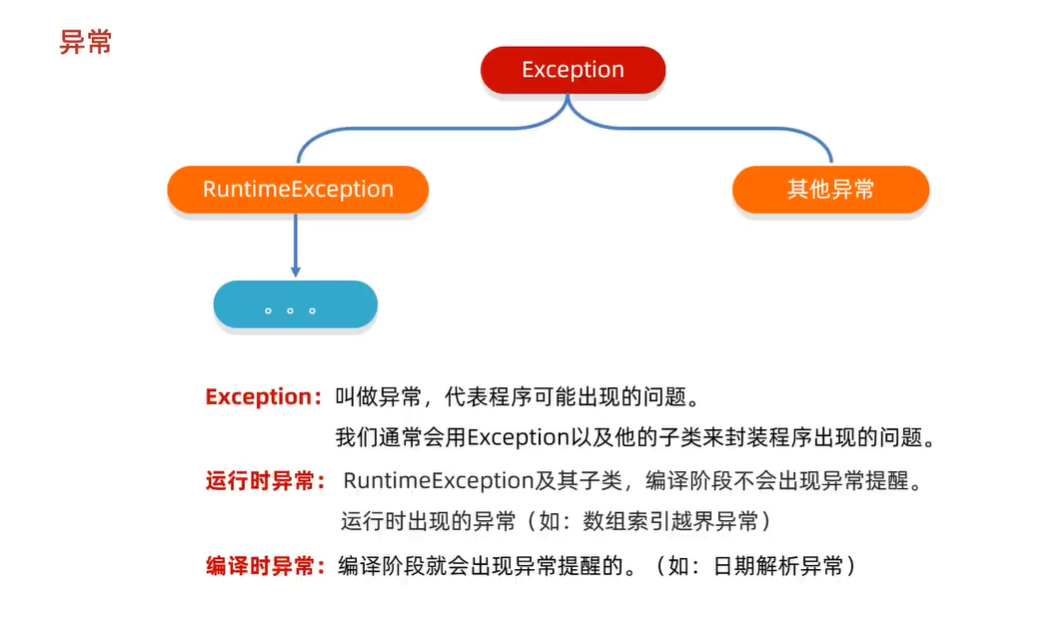Java基础-异常
迪丽瓦拉
2025-05-28 12:45:34
0次
1.异常概述
概念:程序中可能出现的问题
异常体系的顶层父类是Exception
图解


2.异常的处理方式
2.1 JVM默认的处理方式
- 把异常的名称和原因以及出现异常的位置大的信息输出在控制台
- 程序停止执行,下面的代码不会再执行了
2.2 自己处理(捕获异常)
try{可能出现异常的代码} catch (异常类名 变量名) {异常的处理代码}2.2.1 try catch finally 执行顺序
没有return 语句
1.try没有异常:顺序为try→finally
2.try有异常:顺序为try→catch→finally
有return 语句
1.try里有return
当try中带有return时,会先执行return前的代码,然后暂时保存需要return的信息,再执行finally中的代码,最后再通过return返回之前保存的信息。
package cn.sxau.异常;public class 捕获异常的执行顺序 {public static void main(String[] args) {System.out.println(testReturn1());}private static int testReturn1() {int i = 1; //第1步,1try {i++; //第2步, 2 System.out.println("try:" + i); //第3步,输出 try:2return i; //第3步,得到2 第7步 输出 2} catch (Exception e) {i++; System.out.println("catch:" + i);} finally {i++; //第5步,3 System.out.println("finally:" + i); //第6步,输出 finally :3}return i;}}

2.catch里有return
catch中return与try中一样,会先执行return前的代码,然后暂时保存需要return的信息,再执行finally中的代码,最后再通过return返回之前保存的信息
package cn.sxau.异常;public class 捕获异常的执行顺序 {public static void main(String[] args) {System.out.println(testReturn1());}private static int testReturn1() {int i = 1; // 第一步try {i++; //第二步 得到 i=2System.out.println("try:" + i); //第三步 输出 try:2int x = i / 0 ; //异常} catch (Exception e) {i++; //第4步: i= 3System.out.println("catch:" + i); //第5步: 输出 catch:3return i; //第6步: 得到 3 第9步 ,输出3} finally {i++; //第7步: i= 4System.out.println("finally:" + i); //第8步 ,输出 finally = 4}return i;}}

3.finally里有return
当finally中有return的时候,try中的return会失效,JVM是忽略了try中的return语句。在执行完finally的return之后,就不会再执行try中的return
package cn.sxau.异常;public class 捕获异常的执行顺序 {public static void main(String[] args) {System.out.println(testReturn4());}private static int testReturn4() {int i = 1; //第一步 1try {i++; //第二步 i=2System.out.println("try:" + i); //第三步 输出try: 2return i; //第4步 :得到 2} catch (Exception e) {i++;System.out.println("catch:" + i);return i;} finally {i++; //第5步 , i=3System.out.println("finally:" + i); //第6步 : 输出 finally:3return i; //第7步:输出 3}}}

2.3 抛出异常
- throws:写在方法定义处,表示声明一个异常告诉调用者,使用本方法可能会有那些异常
- throw:写在方法里面,结束方法,手动抛出异常对象,交给调用者方法下面得代码不再执行
package cn.sxau.异常;public class 抛出异常 {public static void main(String[] args) throws Exception {int[] arr = {1, 2, 3, 4, 5};System.out.println(getMax(arr));}public static int getMax(int[] arr) {if(arr == null){throw new NullPointerException();}if(arr.length ==0){throw new ArrayIndexOutOfBoundsException();}System.out.println("测试代码");int max = 0;for (int s : arr) {if (max < s) {max = s;}}return max;}
}
相关内容
热门资讯
Linux-scheduler...
四、调度域 SDTL结构 linux内核使用SDTL结构体来组织CPU的层次关系 struct sc...
托福口语21天——day5 发...
目录 一、连读纠音 二、语料输入+造句输出 三、真题 一、连读纠音 英语中的连读方式有好几种...